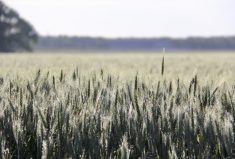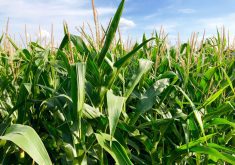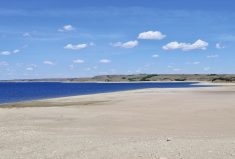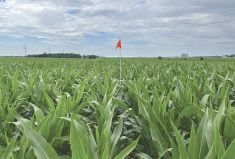Whether it’s in a wagon full of corn, a load of fertilizer, a jug of fungicide, a robotic milker or a new tractor, farmers always look at whether it will provide a return on investment. For those with the option, irrigation is another item to add to the ROI list.
Until recently, irrigation was more of a given for high-value crops such as tomatoes or potatoes, but advances in precision systems and higher grain and oilseed prices have prompted more growers to consider its advantages.
They include farmers who saw the drier conditions in parts of midwestern Ontario in 2022. There is a growing realization that one more factor in the decision is managing water with drainage tile for excess and irrigation for shortages.
Read Also

Could crop sharing be a viable option for your farm?
Crop sharing could be a good option for young and beginning farmers.
“The interest in irrigation in general has grown in the past five years,” says Friedhelm Hoffmann, precision ag and fertigation agronomist with Lakeside Grain and Feed Ltd., in Forest, Ont. “Certainly, in the high-value crops it gets more attention, especially in the drip-tape technology, but the row-crop industry’s discussion is flaring up on irrigation and its possibilities, especially after this year’s drought conditions.”
Hoffmann has been assessing the value of irrigation since the early 2000s, including fertigation, drip-tape technologies and pivot designs. With higher commodity prices, and on fields with lighter soils, managing water for higher yield is becoming more attractive. At the same time, precision ag technologies have become more user-friendly, with more options enabling cash crop growers to add “moisture management” to the list of operations for their fields.
“Precision ag is more important now for equipment and applications as variable rates in fertilizer apps and sprays due to the higher input costs,” says Hoffmann, adding there are still calculations for justifying the value of irrigation. “There is software out there that helps with some mechanicals like pivot irrigation systems where it still needs effort and time to implement and operate. Water filters, meters and other components that calculate and regulate are improvements in technology but they still need to be calibrated and troubleshot.”
Precise managements and responses
Hoffmann says more growers want to give their crops the best start possible with supplemental moisture in-season. He cites drip irrigation as the best for placing the right amount in the right place. By incorporating precision ag systems, it’s possible to monitor root pressure demands. Scouting programs and other software for traditional precision ag have more components to include irrigation.

“The irrigation system can be triggered with those, and pivots can be tied in with such software,” Hoffmann says. “When it comes to fertigation, that’s a little trickier, but it’s very well possible. There will be a lot of development coming in the next few years.”
That timing may coincide with expectations of a worsening drought or dry weather. In the U.S., regions of the Great Plains and the Midwest saw drought expand north and east during 2022. Kansas, Iowa, Nebraska and the Dakotas saw drought-stricken areas increase in size during the fall. Minnesota, Illinois, Indiana, Ohio and Michigan had recorded excessive dryness, and conditions have spread into Missouri and east of the Mississippi.
“If we can control water better for our crops, we’re one step closer to getting a grip on nutrient control,” says Hoffmann, noting the added benefit of providing sufficient moisture along with needed nutrients. “That allows us to know what nutrients and what amount and at what time is needed in a growing season.”
Moisture management is taking on greater importance for another reason — soil health. Providing sufficient moisture early in the season after planting or during midsummer may help the soil profile with water and nutrient cycling and structure.
Fertigation
The efficiency of soluble fertilizers with fertigation ranges from 30 to 60 per cent higher than traditional dry fertilizer. Depending on soil and other environmental influences, fertigation can be highly cost-efficient and maximize yield. Technology and expertise have increased for application of soluble fertilizers. Israel has spearheaded those technologies and is helping make decisions on the growth stage that’s best for applications.
[RELATED] Grainews: A new way to water crops
Hoffmann adds that further efficiencies are possible when taking varietal and hybrid selection into consideration. Some respond to water management and fertility differently than others. It’s best to consult a seed dealer or trusted advisor.
Costs associated with irrigation alone are always a determining factor and can provide something of a “sticker shock.” Hoffmann says four years ago, costs were about $60,000 for a drilled well and $10,000 to $15,000 for a pond, and irrigation was “walk-away” simple. Today, total cost for the pivot system is roughly $80,000 for the well (depending on the depth and casing) plus the cost for the pond (depending on how large). Then there’s cost of the irrigation system itself: a drip design is roughly $300 per acre, including the hardware, pump and filter. A 250- to 300-foot-wide overhead boom is roughly $40,000 to $50,000 and the centre pivot costs between $40,000 and $120,000.
















